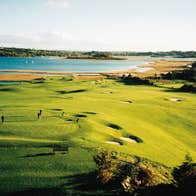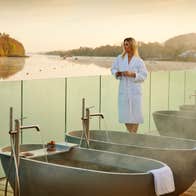Dublin
Portmarnock Golf Club
Portmarnock Golf Club is a contender for best course in Ireland because everything about it is as close to perfect as you could ever find on a links. From the opening tee shot – elegant, understated clubhouse on your left, the still waters of the estuary on your right – you know you’re somewhere special, but it’ll take a few holes just to understand how good this course is and why it has hosted so many professional tournaments since it first opened for play in 1894.
The best golf courses offer a fair challenge, and Portmarnock is every bit the decent taskmaster.
The strategically positioned pot bunkers will swallow up any errant shot, but sharp bunker play is helped by perfectly fluffy sand. But the course’s true genius is on the upturned saucer-like greens: the best advice is to ignore the flag and aim for the middle lest you want to trundle down a runoff, making par an over-ambitious dream.
You’re surrounded by the sea, so the elements play a significant role here. The wind can be a significant factor, constantly changing in both strength and direction. This unpredictability adds an extra layer of challenge, as you need to adapt your game on almost every shot.
And it’s not just amateurs who struggle: at the 1976 Irish Open, eventual winner Ben Crenshaw declared the 15th to be “the sweetest little par five I’ve ever played.” The 15th is a 204-yard par three.
What makes Portmarnock special is not just the golf itself, but the feeling that you’re experiencing a piece of Ireland's rich golfing heritage, where the game is played as it was meant to be, against a backdrop of stunning natural beauty and ever-changing conditions.
County Wicklow
The European Club, Brittas Bay
When Pat Ruddy set about designing a golf course straddling the headland at the southern end of Brittas Bay, he had the lofty ambition of creating a course that would rank among the best in the country. The result is the 20-hole links at The European Club, a masterpiece of modern design. Its signature holes are highly memorable: the reachable par-five 3rd, the par-four 7th (one of the world’s great golf holes) and the spectacular, 596-yard par-five 13th, which runs alongside the coast and features a green that is 127 yards deep. Depending on where the flag is cut, that can mean the difference of up to four clubs.
The two extra holes – 7a and 12a (where the green sits at the base of a huge dune) – were built to serve as relief when other holes were closed for maintenance but are also exceptional challenges. The European Club isn’t shy about its length, but ultimately its best defence is the weather, which can make it tough for even the very best players. On calm days, though, it’s just inviting you to play well.

Druids Glen Golf Resort
If a golf course is nicknamed the ‘Augusta of Ireland,’ expectations are inevitably going to be high. But ever since it opened for play in 1995, Druids Glen Golf Resort set its sights on being one of the world’s best courses. Four decades and multiple pro tournaments later, the comparison still stands up, its meticulously manicured fairways and stunning floral displays providing a visually spectacular golfing experience. Each hole is uniquely crafted through the rolling parkland, dotted with ancient trees and vibrant azaleas that bloom spectacularly in season, mirroring Augusta's iconic aesthetic.
Not afraid to lean into a good thing, the stretch of holes from the 12th to the 14th are known as ‘Ireland’s Amen Corner,’ which, like the home of the Masters, is a run of holes as beautiful as they are a potential card-wrecker. In 2003, the resort added a second course, Druids Heath, which has slightly more of a links feel to it, with lots of gorse bushes and plenty of strategically placed pot bunkers. Altogether a standout destination in Irish golf.

Powerscourt Golf Club
When the DePoer family established their enormous estate in the 12th century, the only games played here were of the hunting kind. More than 800 years, golfers go hunting for low scores and birdies across two spectacular courses that make up Powerscourt Golf Club.
Designed by Peter McEvoy, the East Course is known for its scenic beauty, characterised by rolling fairways and panoramic views of the Wicklow Mountains and the Irish Sea. The course layout, measuring over 7,000 yards from the back tees, emphasises strategic play, with well-placed bunkers and water hazards. The par-three 16th hole is particularly notable, where you hit over a water hazard to a sloping green, with the Sugarloaf Mountain as a backdrop.
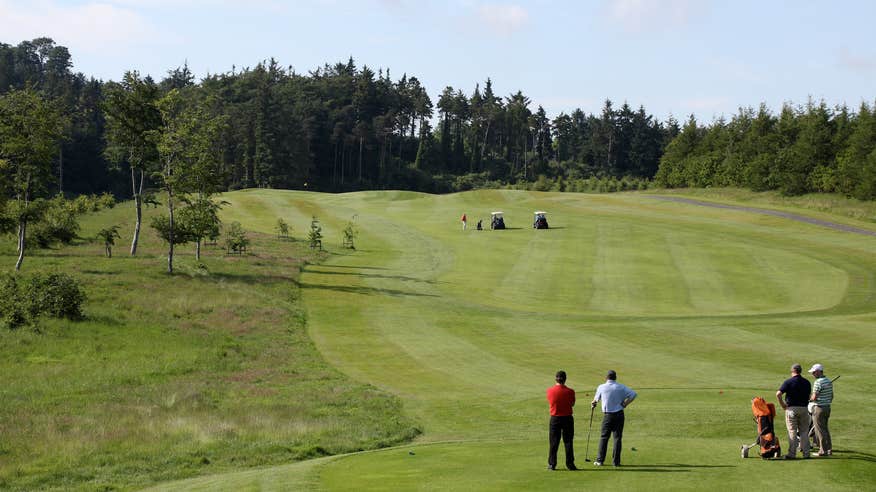
The newer West course was designed by renowned golf course architect David McLay Kidd, who also created the famous Bandon Dunes resort in Oregon. His design puts a premium on engagement with the natural environment, which means lots of gorgeous scenery. The par-four 7th hole is a highlight, with a fairway that doglegs right towards a well-protected green. Opinions are divided on which is the better course, but the West is more challenging than the East, appealing to low-handicap golfers seeking a demanding round.
County Louth
County Louth Golf Club
County Louth Golf Club, better known as Baltray, mightn’t have the dramatic charm of some of the best-known courses on the west coast, but it offers a quintessential Irish links experience. On a spit of land close to the mouth of the River Boyne, this course is a bit of a hidden gem, but it's cherished by those who know it for its classic links character and understated quality.
Tom Simpson laid out its 18 holes in 1938, using a unique routing that meanders through towering dunes and natural valleys, creating a varied and intriguing test of golf. Each hole presents its own challenges, with strategic bunkering and natural hazards that require thoughtful navigation.
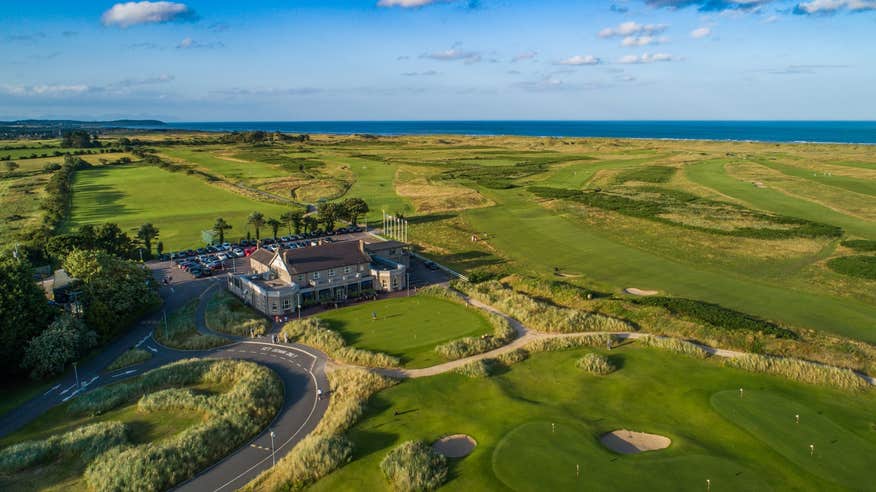
A standout feature is its playability: unlike some links courses that can be brutally punishing, Baltray strikes a balance between challenge and fairness. The greens are generally large and true, offering a variety of pin placements that can change the nature of each hole from day to day. You’re on the sea so the wind is a constant factor. This variability means no two rounds are ever quite the same and demands a creative approach to shot-making, with players needing to adapt to the conditions on the fly.
The par-threes at County Louth are particularly noteworthy, each with its own distinct character and challenge. At 163 yards the uphill 7th is hardly a brute, but come up short and two devilishly placed bunkers will make par that much harder to get. The 13th hole is a stunning short hole played to a green surrounded by dunes.
County Meath
Killeen Castle Golf Resort
Jack Nicklaus never does things by halves. Killeen Castle, which has watched over this 600-acre estate near Dunshaughlin since 1181, is a fitting venue for Nicklaus’ grand vision of a resort-style championship course. While every hole is distinctive at Killeen Castle Golf Resort, they all have the Nicklaus imprimatur, which is all about risk-reward: hit your drive on the right line (usually over a strategically placed bunker) and you’re in prime position to make the most of the tricky second shot.
Killeen builds to a dramatic crescendo that reveals itself in the final three holes, arguably the best finishing holes in Ireland. The par-three 16th and par-four 17th both have water in play, demanding both length and accuracy off the tee. The 18th is reminiscent of the finishing hole at Jack’s home course at Memorial in Ohio; but here the backdrop is the stunning castle, which served as the seat of the Plunkett family, the earls of Fingall, from 1403 until 1951, and will open in 2025 as a luxury hotel. It’s as grand a finish as you could possibly imagine in Ireland.
County Kildare
K Club
The K Club might have two outstanding courses, but most of the focus is on the host of the 2006 Ryder Cup and multiple editions of the Irish Open – the Palmer North Course. And it’s entirely deserving of all that attention as the Arnold Palmer-designed course is a beauty. It masterfully integrates natural landscapes into its design, which includes rolling fairways, perfectly positioned clusters of bunkers – and water: the River Liffey meanders through the course and makes plenty of strategic appearances. The 4th has water left and right; the green on the signature 7th is on an island surrounded by water, which follows you along the length of the 8th. The order of the two nines is reversed when the pros come to play, which leads to a satisfying finish on the majestic 18th (the amateur’s 9th), which demands a perfect shot over…you guessed it…water.
The K Club’s second course, Palmer South, mightn’t get the same star treatment, but it’s no slouch: the terrain is a little more rugged and includes dune-like mounds and large greens. A recent addition to the estate is K Golf World, an indoor simulator where you can play pretty much any golf course in the world.
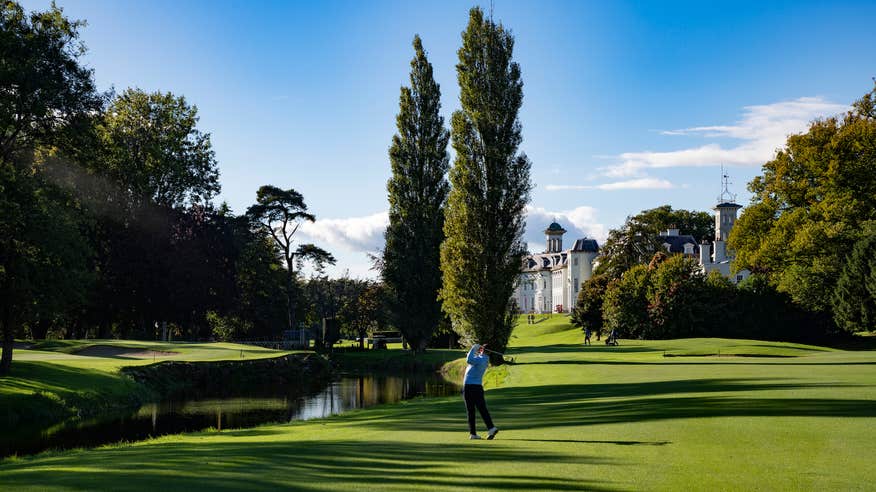
Carton House
Spread across 1100 acres of parkland just outside Maynooth, the ancestral estate of the Fitzgerald family is now better known as one of the best golfing destinations along the east coast. There are two championship courses at Carton House: a classic parkland designed by Mark O’Meara that weaves its way through ancient woods and meanders along the River Rye; and the links-like Montgomerie course, designed by European tour legend Colin Montgomerie. Here you’ll find firm fairways, cavernous bunkers (often in the middle of those fairways) and large, multi-layered greens that put a premium on accuracy with your approach. Opinions are divided on which is the better course, but it’s generally accepted that the Montgomerie is a more rugged, demanding test. However, put together the courses offer a complete and memorable golfing experience. After your round, book in for a celebratory dinner at the opulent, Michelin-starred Morrison Room in Carton House.

County Laois
The Heritage Golf Resort
As a classic US-style resort course, the Heritage Golf Resort feels familiar but its design is guaranteed to bring something new to the table. The course is the work of designer Jeff Howes with a huge input from the legendary Seve Ballesteros – the design speaks volumes of their vision with its strategic bunkering and thoughtful use of water hazards. You'll find the greens running fast and true, rewarding those well-judged putts.
Take the 214-yard par-three 4th, for instance, where a well-struck shot is key due to the water lurking to catch any missteps. Or the 8th, where the green sits snugly, almost like an amphitheatre waiting for the drama of your tee shot to unfold. Then there's the 12th, a par-four that requires you to miss a cluster of bunkers with your drive to have any chance of getting on the green in two. This hole, with a backdrop of the Slieve Bloom Mountains, perfectly captures the essence of the Heritage – a course that's as much about the landscape as it is about the game. The key to a successful resort design is that it can be played by golfers of all levels, so it’s also wide and forgiving. Sure, the wind can play tricks, turning a straightforward hole into a puzzle, but isn't that part of the fun? And when you’re done, there’s a five-star luxury spa and resort to console even the toughest of golfing experiences.
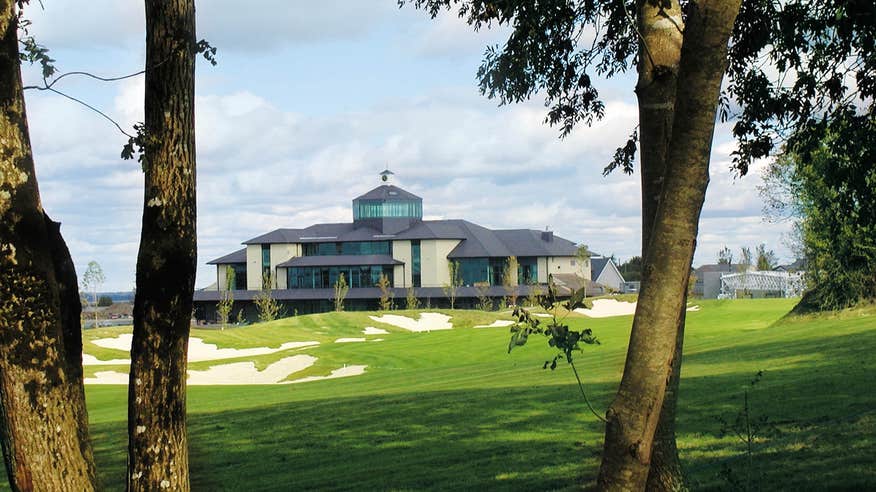
County Kilkenny
Mount Juliet Golf Club
A reputation firmly anchored in the world of top-class golf doesn’t mean that Mount Juliet Golf Club rests on its laurels. The Jack Nicklaus-designed course is a testament to accessible yet thoughtful golf architecture that makes playing here an enjoyable experience for all levels of golfing skill. The fairways are generous, but don't be fooled – the strategic placement of bunkers and the occasional water hazard call for a sharp mind and a steady hand.
The standout 3rd hole, if played off the back tees, calls for 180 yards of carry over a lake. The 11th is another gem, a par three where club selection is governed by the wind's fickle mood. For those who find the back tees a bit daunting, Mount Juliet doesn't snub the high handicappers; the forward tees offer a fair challenge.
It's easy to appreciate the course's condition – the greens are kept fast, and the fairways, even after a downpour, are surprisingly playable. But it's not all about the golf. The Mount Juliet Estate itself, with its mature trees and gentle rivers, adds a bucolic feel to the experience and is one of Ireland’s finest country-house hotels, home to the Michelin-starred Lady Helen Restaurant.
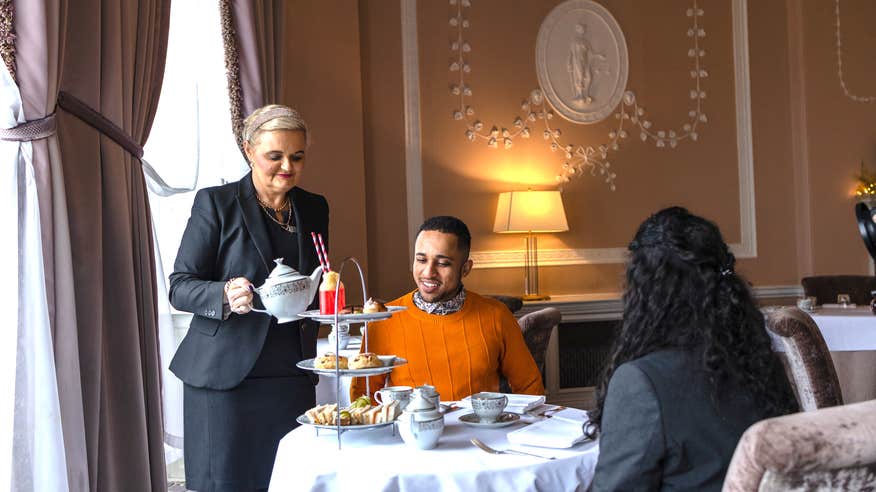
County Westmeath
Glasson Golf Club
In a golf-mad country full of great courses, the 18-hole course at Glasson Golf Club is a real sleeper. The Christy O’Connor Jr-designed championship course mightn’t be at the top of a lot of ‘best of’ lists, but this is a fabulous track that manages to be both memorable and unassuming. For starters, its design is a clever composition of golfing challenges that makes you think about every club in your bag.
The front nine is a solid warm-up, but it's the back nine where Glasson truly shines. The 10th hole, a high tee par-five, gives a view that's worth the green fee alone. Greens are consistently well-kept, offering a smooth roll if your putting is on point. With each hole, you're treated to views of Lough Ree, which isn't just a backdrop but a strategic player in the game—especially on the signature par-three 17th, where a poorly struck shot will likely find a watery grave or, at best, the long reeds that line the banks of the lake. While the course won't bully you into submission, wayward shots can be punished by cleverly placed bunkers and water hazards. It's a course that rewards the thoughtful golfer rather than the power player. One of Irish golf’s best-kept secrets.

County Cork
Old Head Golf Links
Built on a headland that extends for two miles into the Atlantic, Old Head Golf Links' spectacular setting alone is worth the green fees. And that’s before you’ve even tackled the first of its 7,100 yards, which provide a rigorous test for any golfer’s abilities.
With each hole, the course unfurls a new chapter in its thrilling layout. Take the 4th hole, for instance; a demanding par-four cliff-top chasm that runs along the promontory’s edge to an elevated green perched right on top of the cliff face. The 12th is another intimidating brute, a par-five known as the ‘Razor’s Edge,’ with the ocean lurking ominously to the left. The fairways, a mix of bent grass and fescue, are manicured to allow for the ground game that links golf is known for. The wind can be a merciless adversary, transforming seemingly straightforward holes into a battle against the elements. Golfers who are not accustomed to playing in windy conditions might find Old Head a little more than they bargained for. But that’s the whole point of playing here, as the setting isn’t just a backdrop but an active participant in your round: between shots take a moment to appreciate the sound of the crashing waves below – the perfect soundtrack to your game.
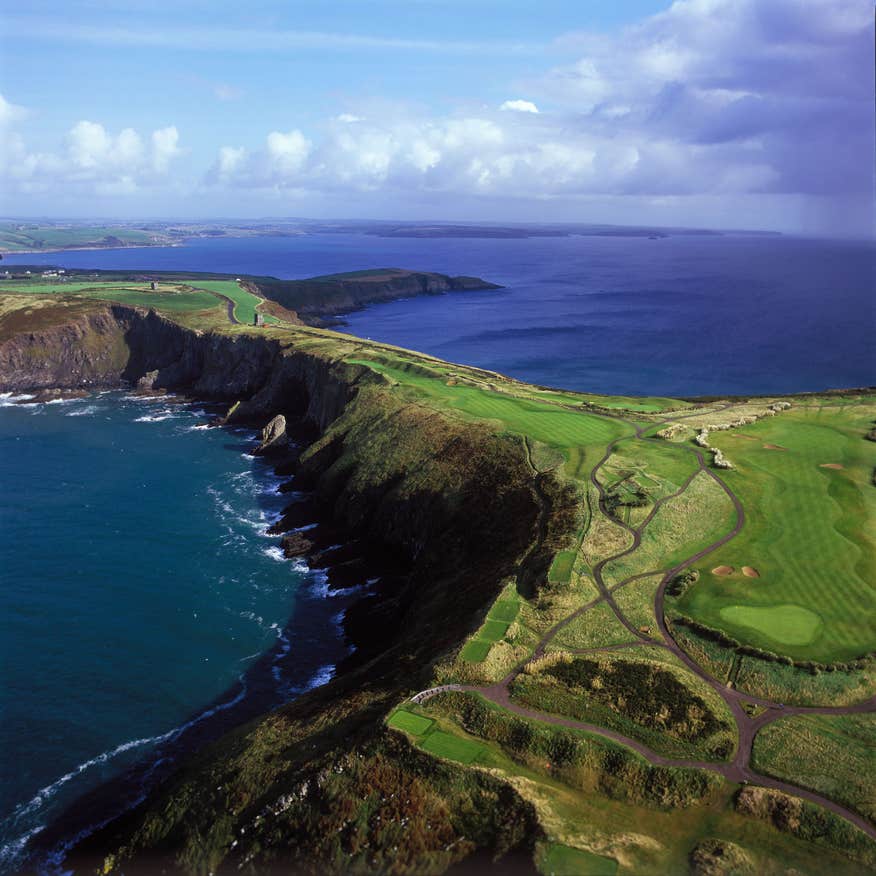
Fota Island Golf Club
Fota Island Golf Club is made up of a trio of golf courses, including a championship course that has hosted three Irish Opens. The Belvelly and Barryscourt courses are beautifully maintained and offer a generous challenge to golfers of all abilities, but the standout experience is on the original Deerpark course, designed in 1990 by Christy O’Connor Jr and Peter McEvoy, and reworked by Jeff Howes in 2020. The par-71 championship course plays through rolling parkland, past ancient woodland and features gorgeous views of Cork Harbour.
The fairways are wide and receptive, but this is far from a straightforward challenge, especially as water is a major feature and is always ready to turn a good score into a bad one. The par-five 10th snakes through the trees and turns sharply left before reaching a green cut into the lakeside – you’ll need to be precise with every shot. Water will play its part in blocking your approach to the 18th, whose other protection is the multi-layered green; even if you clear the water you risk running up a score if you’re on the wrong tier to the flag.
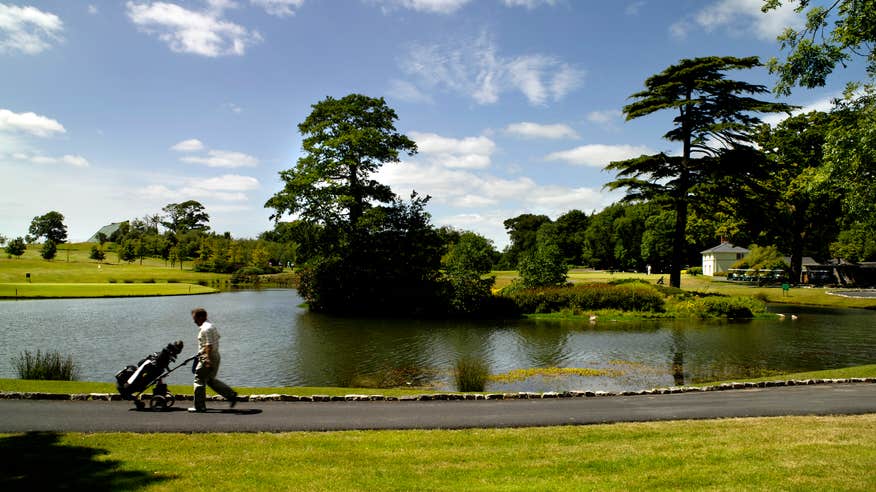
County Kerry
Waterville Golf Links
Strung out along a promontory surrounded by water, the 18 holes at Waterville Golf Links are a golfer’s dream – which is just as its creators intended. The combined efforts of Irish-American Jack Mulcahy, 1948 Masters winner Claude Harmon (father of noted coach Butch) and famous designer Eddie Hackett resulted in the 1973 opening of this remarkable course, which was made even better in the early years of the millennium by Tom Fazio, who later transformed the golf course at Adare Manor.
The course layout weaves through natural dunes, with sloping fairways and well-guarded greens demanding strategic thinking and precision. Each hole has panoramic views of the Atlantic Ocean, while the ever-present sea breeze adds an extra layer of challenge. When it comes to signature holes, you’re spoilt for choice with six – three par-threes and three spellbinding par-fives. The view from the 17th – an elevated par-three called Mulcahy’s Peak – is as good as any you’ll find anywhere on the island, and reinforces the profound sense of seclusion and connection with nature that is at the heart of an experience here, and which prompted three-time PGA Championship winner Sam Snead to describe it as a “beautiful monster – one of the golfing wonders of the world."
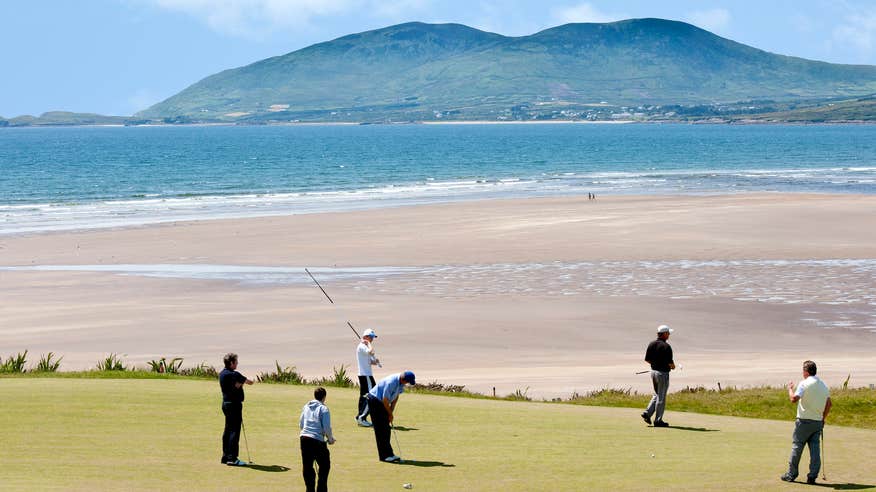
The Old Course, Ballybunion Golf Club
Any conversation about the world’s best golf courses will feature a mention of the Old Course at Ballybunion Golf Club, which Spanish golfing icon Seve Ballesteros once called “a piece of art.” The course's conditioning is sublime, with firm fairways perfect for the ground game and greens (a mix of fescue and bent grass) that roll true and provide a consistent test throughout the round.
Like the very best art, Ballybunion has its idiosyncrasies: the opening tee shot skirts a graveyard tight on your right, but the majesty of the layout soon reveals itself. You meet the Atlantic Ocean on the 6th, and it stays with you for the rest of the round: the 7th, Castle Green, is a cliff-top par-four that encourages you to hit to the right side of the fairway for the best view of the green – but hit it too far right and you’re out of bounds on the beach.
But if you can keep the ball on a relatively straight line (look for the white stone on the dunes at the par-three 15th to know where the flag is tucked) and negotiate the beautifully maintained and well-protected greens, your reward is one of the world’s greatest golfing experiences. The stunning scenery is just an added bonus for this bucket list destination.

Tralee Golf Club
Local folklore has it that golfing legend Arnold Palmer created the first nine and nature did the rest at Tralee Golf Club. Ever humble, Palmer insisted the location was “ideally suited” to a golf course. While it may not have the same international cache as Ballybunion or Waterville, this captivating links course takes in soaring dunes, par-breaking ravines and a coastal location that’s on a visual par with any in the country.
Each hole offers its own unique challenge, with a seamless blend of dunes, rolling fairways, punishing rough and greens that can be both a joy and a menace, depending on the mood of the Atlantic winds. The front nine sets the stage with a traditional links layout, demanding strategic play to navigate the natural contours of the land. The par-five second hole, the Cuilin, is a masterclass in risk and reward, tempting the long hitter to cut the corner yet ready to punish any wayward shot. The 3rd, "The Castle," is a stunning par-three that plays a shade under 200 yards to a green surrounded by water on all sides and is so-named because you can see the ruins of a 13th-century fort just beyond the green.
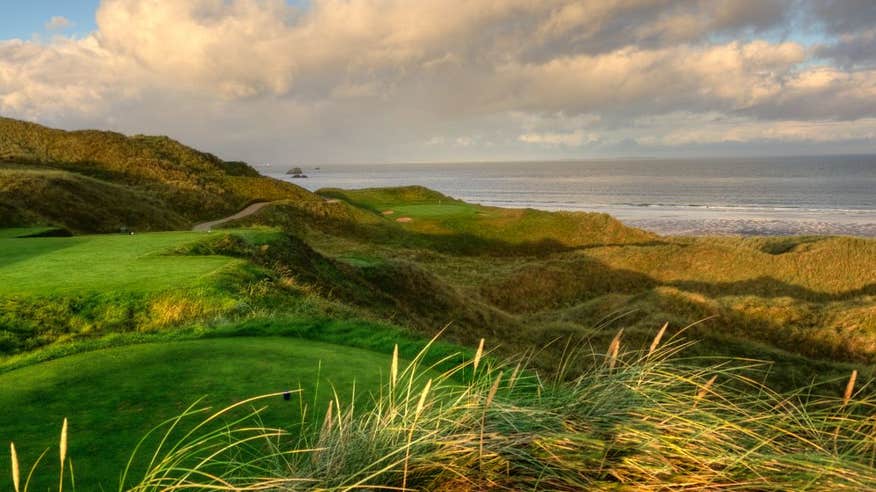
As you make the turn, the back nine greets you with an almost theatrical flair – but the inward challenge is not without its quirks. The par-five 11th is as unforgiving a hole as you're likely to find anywhere: "Palmer's Peak" feels like you're playing up the side of a mountain, albeit one framed by massive sand dunes: two big hits and you still have a full shot into the green.
The blind shots on some holes might confound first-time visitors, and the course can be unforgiving to those unaccustomed to links golf. Still, maintenance is impeccable: the fairways are kept in pristine condition; the greens, true and fast, can be a stern test of one's putting skill, especially when the wind decides to enter the fray. Tralee is a marvel, but like any really great course it’ll take some effort to really appreciate it.
County Clare
Lahinch Golf Club
The Old Course at Lahinch Golf Club is overflowing with golfing pedigree. The course was crafted by ‘Old’ Tom Morris and later redesigned by Alistair Mackenzie (who built Augusta National in Georgia). And like the home of golf at St Andrew’s, Lahinch is very much a part of the fabric of the town, which made its hosting of the 2019 Irish Open an unparalleled success, with the players literally walking off the course into a festive and celebratory atmosphere.
But this would all count for a lot less if the course wasn’t an absolute belter. The layout is a considered and thoughtful journey through rugged dunes, with plenty of blind shots that demand a golfer’s intuition and mastery. A good example is ‘The Klondyke,’ the shortish par-five 4th, where you need to hit a blind second shot over a huge dune to find the green. Morris’ iconic design is also evident on the next hole, The Dell, an elusive par-three where the green is hidden between two hills and a white stone is your only targeting guide.
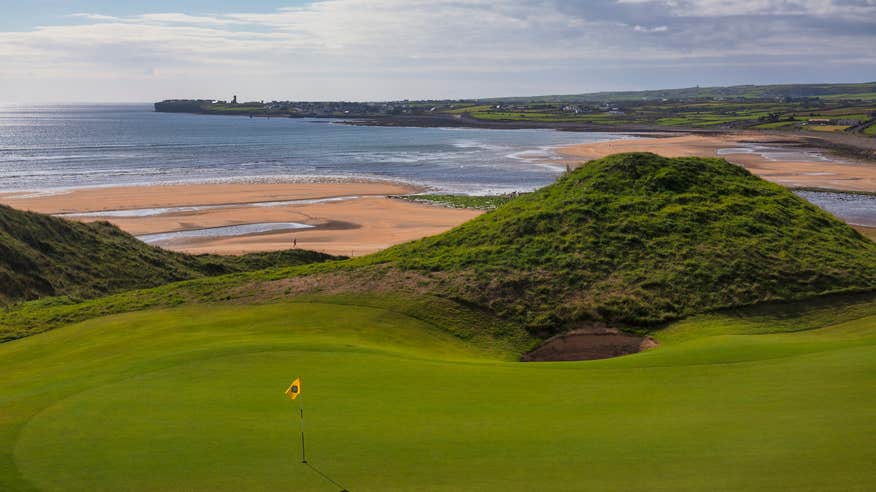
Alistair Mackenzie’s genius is displayed in the natural bunkering and clever use of the ground's natural contours to challenge golfers. The fairways roll naturally with the landscape and the fescue grasses that line them sway with the coastal breezes, providing a pure links experience. The subtly complex greens are maintained to perfection, offering a smooth, fast surface that challenges even the most skilled putters. And it wouldn’t be world-class links without some splendid scenery, either, as the Atlantic Ocean in all its moody vagaries is the ideal backdrop to a round rooted in the best traditions of the game.
Dromoland Castle Golf Club
Dromoland Castle Golf Club, on the grounds of the five-star Dromoland Castle Hotel, is a par-72 course that melds historical grandeur with modern golfing challenge. The original nine-hole layout was re-designed by Ron Kirby and J.B. Carr in 2002, resulting in a championship course whose strategic layout weaves through 450 acres of bucolic landscape, demanding precision and thoughtful play. In 2023, it hosted the Women’s Irish Open, won with a spectacular eagle on the last by Denmark’s Smilla Tarning Sønderby.
The signature hole is the par-three 7th, which plays down into a postage stamp-sized green protected by water on the left and a bunker in the shape of a shamrock on the right. The par-four 9th is designed very much like the 10th on the Brabazon course at the Belfry – big hitters will inevitably be tempted by the 280-yard carry to the green. Its picturesque setting within the estate gives the whole experience a sense of majesty: the par-five 18th offers a stunning finish in front of the castle, making for an unforgettable closing experience.
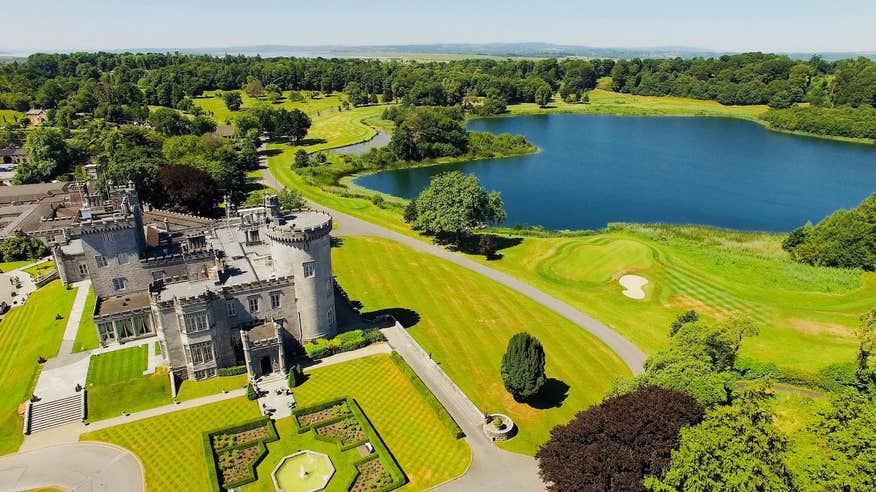
Trump International Golf Links, Doonbeg
Perhaps the most remarkable feature of Trump International Golf Links at Doonbeg is that it feels like it’s been here for a very long time. But rather than a heritage golf course built around a 19th century stately seaside manor, it was conceived of by Kiawah Island's American developers, designed by Greg Norman and only opened for play in 2006. In 2014, the course and hotel were acquired by Donald Trump, whose team improved what was already a superb golf course.
With a variety of holes that ebb and flow with the 100-foot-tall dunes, each one presents its own set of tests. The 1st hole sets the tone with a demanding drive between imposing dunes, while the par-three 14th hole requires a precise shot to a green backed by the Atlantic. The course is full of strategically placed pot bunkers, contoured greens and rolling fairways that call for strategic shot-making. The visual tapestry of the course is as impressive as its design, with the wild Atlantic Ocean framing many of the holes, offering an unforgettable backdrop. Away from the golf course, the five-star Trump International Hotel is one of the best along the west coast.

County Limerick
The Golf Course at Adare Manor
The host of the 2027 Ryder Cup is a testament to world-class golfing excellence. When in 2015 owner JP McManus commissioned noted golf architect Tom Fazio to undertake a major revamp of the par-72 championship golf course at Adare Manor, the result was the transformation of what was already one of the best tracks in the country into an unparalleled golfing experience.
The original routing was maintained, but new additions included pristine bent grass surfaces and subtle but strategic elevations: the new green runoffs are cut tighter and are in better shape than most closely mown putting surfaces. Also new are state-of-the-art drainage and sub-air systems, which provide a buffer against inclement weather and ensure perfect playing conditions year-round.
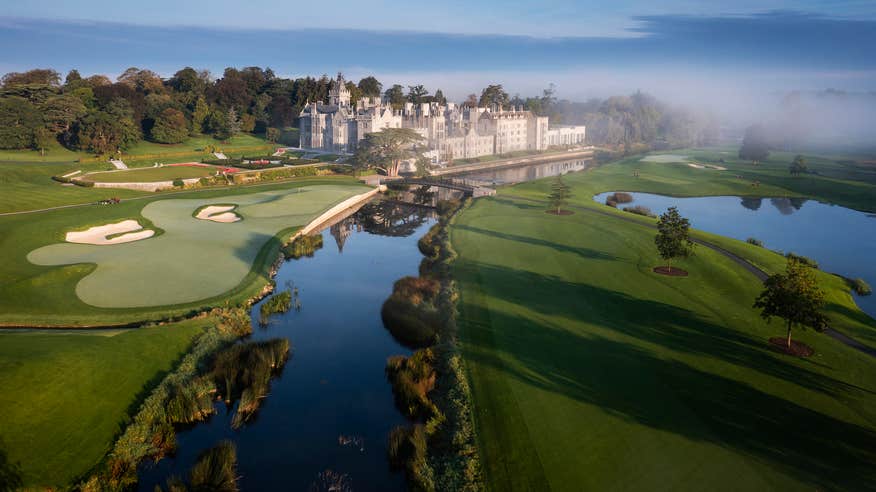
Fazio’s artful blend of challenge and beauty doesn’t disappoint, and all 18 holes have something to offer. Water is in play on both sides of the par-four 9th and, if you manage to avoid both, your approach is to a tough elevated green that demands a high floater if you want to hold it. The par-three 16th is a test of precision thanks to its treacherous island green, while the par-five 18th offers a suitably dramatic finish on a green that is on the other side of the River Maigue.
Away from the course, the club offers top-tier facilities, including a well-equipped pro shop and luxurious clubhouse, enhancing the exclusive and prestigious atmosphere of this golfing haven. And that’s before you’ve stepped into Adare Manor Hotel, which is one of the best in the world, offering unparalleled service and the kind of luxury you’d only find in the most exclusive of accommodations. A bucket list destination as good as any you’ll find anywhere in the world.
County Mayo
Carne Golf Links
The beautiful Carne Golf Links is not just about a challenging round of golf – it’s an immersive encounter with Ireland’s raw, natural beauty. The 27 holes in this remote corner of the Mullet Peninsula are not so much designed as carved into the natural landscape of gigantic, windswept dunes punctuated by far-reaching views across Blacksod Bay to Inis Gluaire. The Hackett 18-hole course (named after legendary designer Eddie Hackett) is built into an extreme landscape that seems to mimic the choppy waves of the neighbouring Atlantic Ocean; there’s rarely a flat lie and plenty of blind approaches. The newer Kilmore course is a nine-hole track that is trickier still. The remote location and the sheer rawness of the setting means this is not a golfing experience for the faint-hearted, but the real aficionado will recognise that this is the game at its most unvarnished. A marvellous experience.
County Sligo
County Sligo Golf Club
Skirting the Atlantic at Rosses Point, just outside Sligo town, County Sligo Golf Club is one of Ireland’s most scenic links. The ocean views are a big part of the draw, but what makes playing here extra special is the backdrop of the distinctive peak of Benbulben, which adds an air of timeless grandeur to the experience. The course was laid out by Harry Colt in 1927 and offers a challenging blend of bumpy fairways, strategic bunkering and layered green complexes.
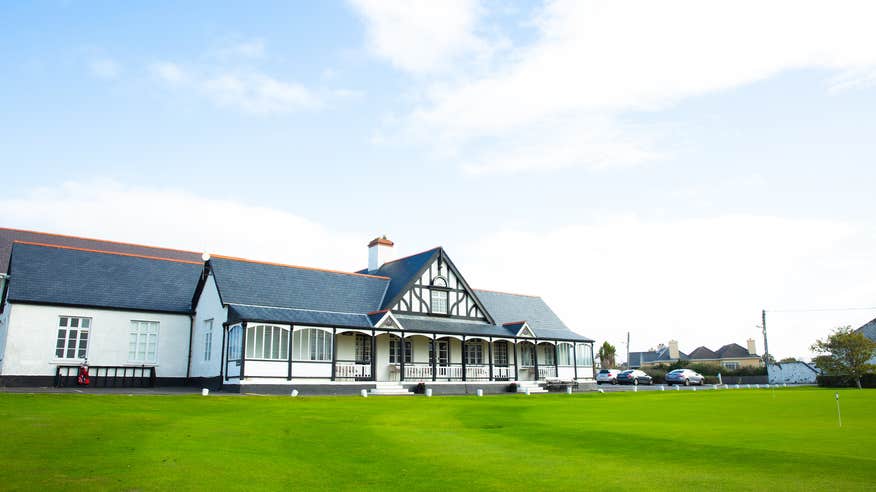
The front nine provide a gentler start, with strategically placed bunkers demanding accurate shots. The real test begins on the back nine, where the Atlantic breeze comes into play, particularly on the 17th, a tricky par-four requiring a well-thought-out approach. The key here is to play smart, respecting the natural contours and wind conditions. It's a course that rewards strategic play more than sheer power.
As befitting its status as one of the best links in the country, it is the yearly host of the West of Ireland Amateur Open Championship.
Enniscrone Golf Club
For dramatic settings, Enniscrone Golf Club comes up trumps. The championship links straddles the rugged shoreline of Killala Bay and is marked by a routing that wends its way through the natural contours of the wild Irish landscape. The most distinctive features are the towering dunes that look down on the fairways and protect many of the rolling greens from the weather. Elevated tee boxes unveil many of the holes, while the occasional blind second shot makes approaches tricky, but once you’re on the green the ball rolls fair and true. If you miss a putt, there’s always the panoramic scenery to console you.

County Donegal
Rosapenna Golf Resort
Rosapenna's three golf courses – the Old Tom Morris Links, Sandy Hills Links and St Patrick's Links – are a triumvirate of golfing excellence carved into the wild landscapes of Ireland’s north western corner.
The Old Tom Morris Links, a par-71, is steeped in history and presents a traditional links challenge with its rolling fairways and classic pot bunkers, requiring strategic navigation. Sandy Hills Links, designed by Pat Ruddy, is a par-72 that contrasts with its towering dunes and narrow fairways, demanding absolute precision and thoughtful club selection. The par-70 St Patrick's Links is the newest addition: noted golfing architect Tom Doak (creator of Barnbougle Dunes in Tasmania) converted two existing golf courses into arguably the best new golf course in the country (it opened for play in 2021).
All three courses are a testament to thoughtful design, embracing the raw natural beauty of the rugged Donegal coast. The green-keeping staff's dedication ensures that the courses are maintained to the highest standards, offering firm, true greens and well-manicured fairways.
Ballyliffin Golf Club
If it hadn’t hosted the 2018 Irish Open, played in glorious sunshine in front of huge crowds, Ballyliffin Golf Club would have remained a closely guarded golfing secret, known only to locals and golf nerds. After 2018, this gem on the Inishowen Peninsula became part of a general conversation about the best links in Ireland.
The tournament was played on the Glashedy Links, a modern marvel of golfing design by Pat Ruddy and Tom Craddock. Its 18 holes are seamlessly integrated into the rugged Irish landscape: while every hole is a winner, the par-three 7th is a standout, playing from a tee box down to a green 100 feet below; as is the par-five 13th, one of the best long holes in Ireland.

Glashedy opened for play in 1995 as Ballyliffin’s second course: the original Old Course opened in 1973 and is every bit as challenging. Its dual architects were Nick Faldo and Mother Nature, who combined to create a course that wends its way through natural sand dunes, offering tricky fairways, perfect greens and some stunning views. Just like at Glashedy the wind can be a capricious companion, but yet, it's this combination of beauty and the beast that makes a round at either course truly unforgettable.
If you want more choice on where to play golf in the Garden County, check out our guide to the best golf courses in Wicklow.



